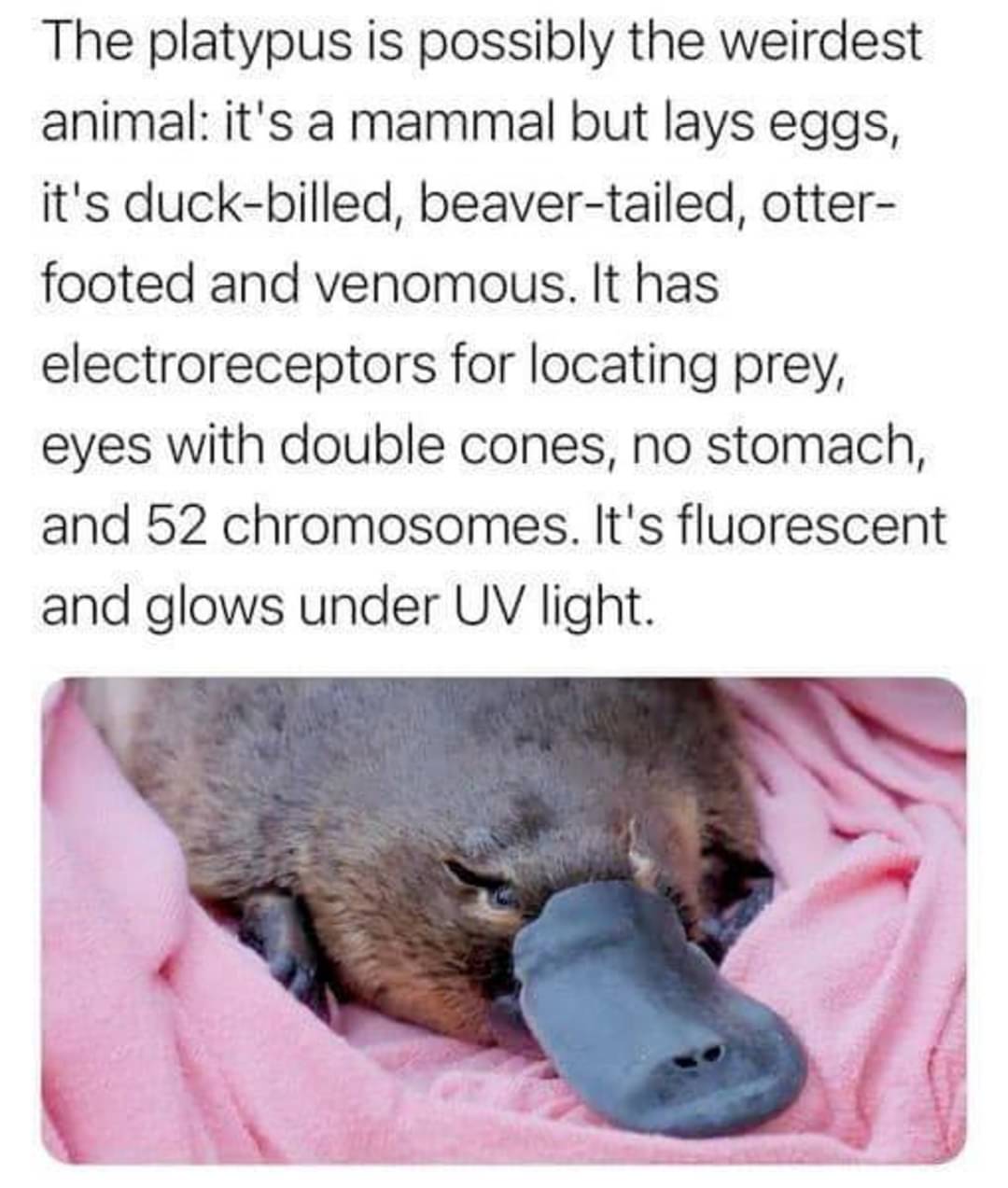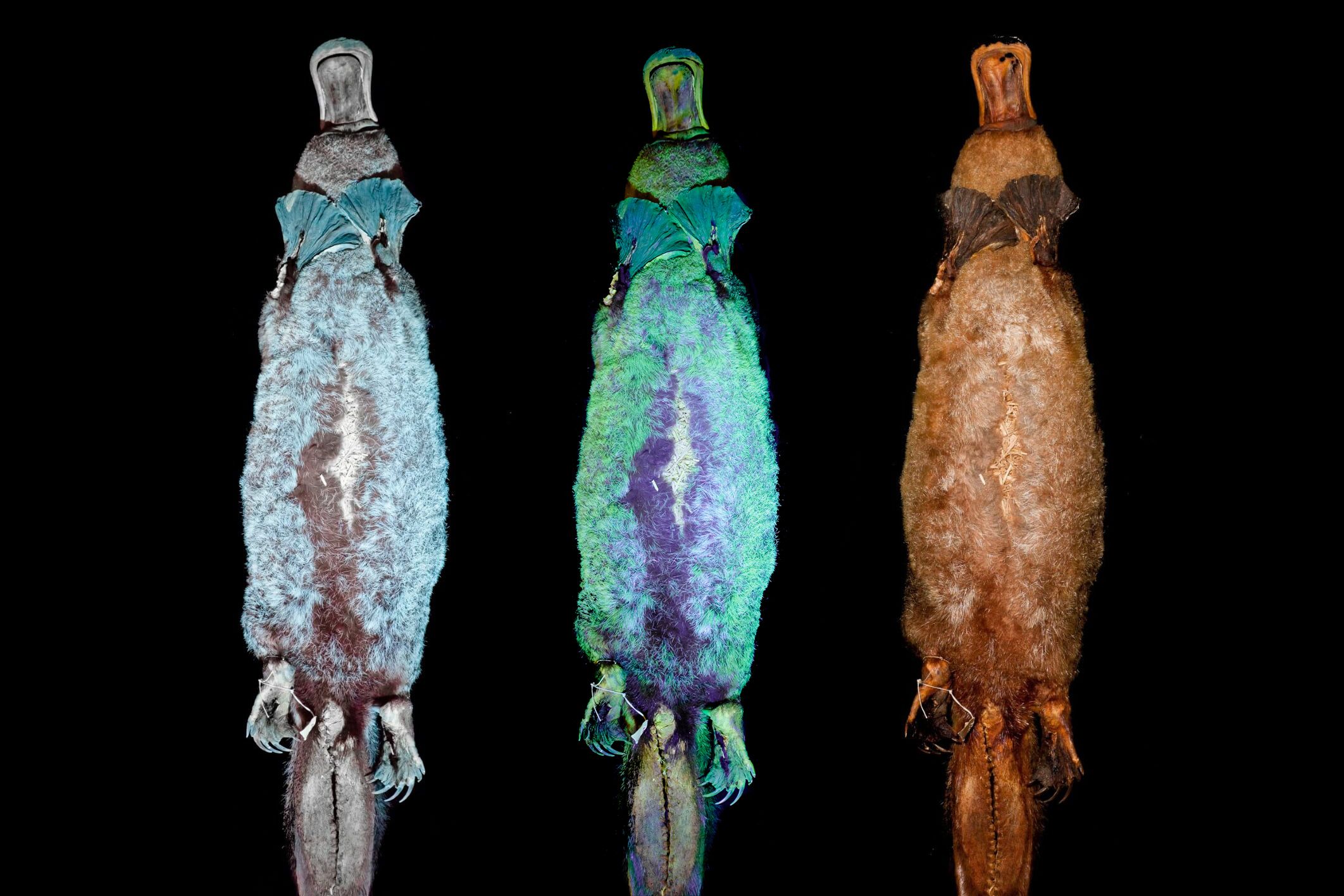As a platypus lays eggs and produces milk, it’s the only animal that can make its own custard.
And echidnas.
I'm not sure if I'm and echidna custard or platypus custard kind of person.
Dark.
Also. Where can I try some?
DM me your card details and I’ll send you a couple of pints from my platypus farm.
Also well known for foiling evil plots while wearing a fedora.
Hey? Where’s Perry?
fedora themed music starts playing
Do be do be do, bah
Do be do be do, bah
No stomach? Hadn't heard that one before
If something is too weird, some of the oddities tend to get overlooked.
They also don't have nipples (though do have mammary glands) and mother platypuses basically sweat milk through their skin for the pups to collect off their fur
what the fuck
The milk pools in grooves on the mother's abdomen, allowing the young to lap it up.
And they sweat milk!
What the hell?
If I remember correctly, they don't have mammalian glands and instead "sweat" thier milk for thier young.
They have glands but no nipples.
They must have glands. Unless they have milk for blood.
The UV light thing wasn't discovered (or at least published) until 2020.
Phineas and Ferb ended in 2015.
It is worth mentioning that when the first stuffed sample of platypus was sent to Britain, the scientists thought it is a joke.
No stomach?! Does food go straight to the colon?
I went down this rathole.
They first grind up the bugs they eat in their mouths, then they have a chamber with bacteria which further reduce their food, then their intestines finish the job.
ETA, since you all are such curious cats:
https://wildlifefaq.com/platypus-stomach/
and
Oh, is it like a gizard type of thing sort of?
Yes, platypuses lost their stomach during evolution, so they basically grind food using gravel and their beak before sending it to the intestine, which has taken on some of the functions performed by stomachs in other animals. Source
Like the universe got lazy and hit the "Randomize for me" button instead LMAO
Will Wright took one look at this thing in an encyclopedia in 2001 and immediately started planning Spore.
And Dan Povenmire was the first to discover the florescence. People Perry the platypus was more scientifically accurate than you thought.
It's also adorable! Also, the babies are called platypups!
When you cheat and choose all the perks in the character creator.
They also have spikes in their hind legs that they use to deliver an extremely painful venom that can paralyze small animals.
Bin parts build
I'd like to be, oooohhhh my favorite animal
I want to be, oooohhhh my favorite animal
I'd be a platypus, for you
Science Memes
Welcome to c/science_memes @ Mander.xyz!
A place for majestic STEMLORD peacocking, as well as memes about the realities of working in a lab.

Rules
- Don't throw mud. Behave like an intellectual and remember the human.
- Keep it rooted (on topic).
- No spam.
- Infographics welcome, get schooled.
This is a science community. We use the Dawkins definition of meme.
Research Committee
Other Mander Communities
Science and Research
Biology and Life Sciences
- !abiogenesis@mander.xyz
- !animal-behavior@mander.xyz
- !anthropology@mander.xyz
- !arachnology@mander.xyz
- !balconygardening@slrpnk.net
- !biodiversity@mander.xyz
- !biology@mander.xyz
- !biophysics@mander.xyz
- !botany@mander.xyz
- !ecology@mander.xyz
- !entomology@mander.xyz
- !fermentation@mander.xyz
- !herpetology@mander.xyz
- !houseplants@mander.xyz
- !medicine@mander.xyz
- !microscopy@mander.xyz
- !mycology@mander.xyz
- !nudibranchs@mander.xyz
- !nutrition@mander.xyz
- !palaeoecology@mander.xyz
- !palaeontology@mander.xyz
- !photosynthesis@mander.xyz
- !plantid@mander.xyz
- !plants@mander.xyz
- !reptiles and amphibians@mander.xyz
Physical Sciences
- !astronomy@mander.xyz
- !chemistry@mander.xyz
- !earthscience@mander.xyz
- !geography@mander.xyz
- !geospatial@mander.xyz
- !nuclear@mander.xyz
- !physics@mander.xyz
- !quantum-computing@mander.xyz
- !spectroscopy@mander.xyz
Humanities and Social Sciences
Practical and Applied Sciences
- !exercise-and sports-science@mander.xyz
- !gardening@mander.xyz
- !self sufficiency@mander.xyz
- !soilscience@slrpnk.net
- !terrariums@mander.xyz
- !timelapse@mander.xyz

